助动词do,does的用法
- 格式:doc
- 大小:26.00 KB
- 文档页数:2
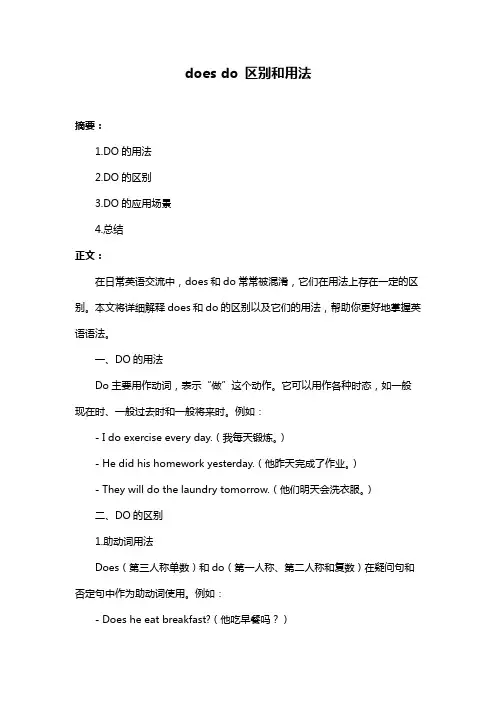
does do 区别和用法摘要:1.DO的用法2.DO的区别3.DO的应用场景4.总结正文:在日常英语交流中,does和do常常被混淆,它们在用法上存在一定的区别。
本文将详细解释does和do的区别以及它们的用法,帮助你更好地掌握英语语法。
一、DO的用法Do主要用作动词,表示“做”这个动作。
它可以用作各种时态,如一般现在时、一般过去时和一般将来时。
例如:- I do exercise every day.(我每天锻炼。
)- He did his homework yesterday.(他昨天完成了作业。
)- They will do the laundry tomorrow.(他们明天会洗衣服。
)二、DO的区别1.助动词用法Does(第三人称单数)和do(第一人称、第二人称和复数)在疑问句和否定句中作为助动词使用。
例如:- Does he eat breakfast?(他吃早餐吗?)- She doesn"t do exercise.(她不锻炼。
)2.替代动词Does可以用作替代动词,表示某个动作的发生。
例如:- She doesn"t smoke, does she?(她不抽烟,对吗?)三、DO的应用场景1.一般疑问句:Does用于询问某人是否做过某事,或者询问某事是否发生。
- Does she like coffee?(她喜欢喝咖啡吗?)2.否定回答:Do的否定回答要用no,does的否定回答要用don"t。
- Do you speak French? - No, I don"t.(你会说法语吗?- 不,我不会。
)3.肯定回答:Do的肯定回答要用yes,does的肯定回答要用does。
- Does she play the piano? - Yes, she does.(她会弹钢琴吗?- 是的,她会。
)四、总结does和do在英语中都有“做”的意思,但它们在用法上存在一定的区别。
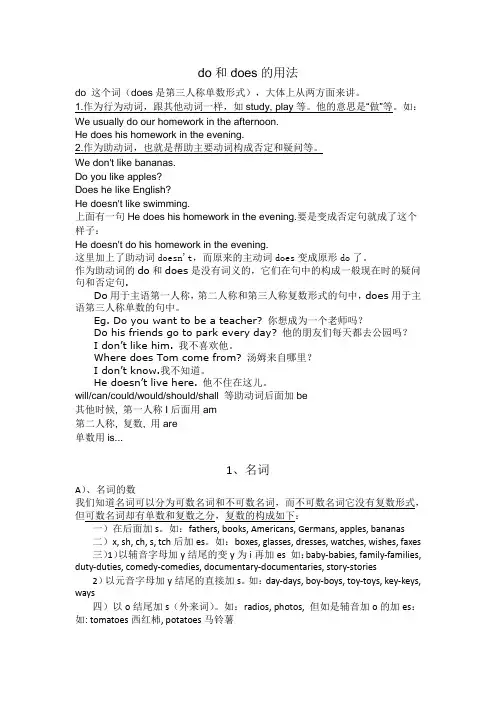
do和does的用法do 这个词(does是第三人称单数形式),大体上从两方面来讲。
1.作为行为动词,跟其他动词一样,如study, play等。
他的意思是“做”等。
如:We usually do our homework in the afternoon.He does his homework in the evening.2.作为助动词,也就是帮助主要动词构成否定和疑问等。
We don't like bananas.Do you like apples?Does he like English?He doesn't like swimming.上面有一句He does his homework in the evening.要是变成否定句就成了这个样子:He doesn't do his homework in the evening.这里加上了助动词doesn't,而原来的主动词does变成原形do了。
作为助动词的do和does是没有词义的,它们在句中的构成一般现在时的疑问句和否定句.Do用于主语第一人称,第二人称和第三人称复数形式的句中,does用于主语第三人称单数的句中。
Eg. Do you want to be a teacher? 你想成为一个老师吗?Do his friends go to park every day? 他的朋友们每天都去公园吗?I don’t like him. 我不喜欢他。
Where does Tom come from? 汤姆来自哪里?I do n’t know.我不知道。
He doesn’t live here. 他不住在这儿。
will/can/could/would/should/shall 等助动词后面加be其他时候, 第一人称I后面用am第二人称, 复数, 用are单数用is...1、名词A)、名词的数我们知道名词可以分为可数名词和不可数名词,而不可数名词它没有复数形式,但可数名词却有单数和复数之分,复数的构成如下:一)在后面加s。
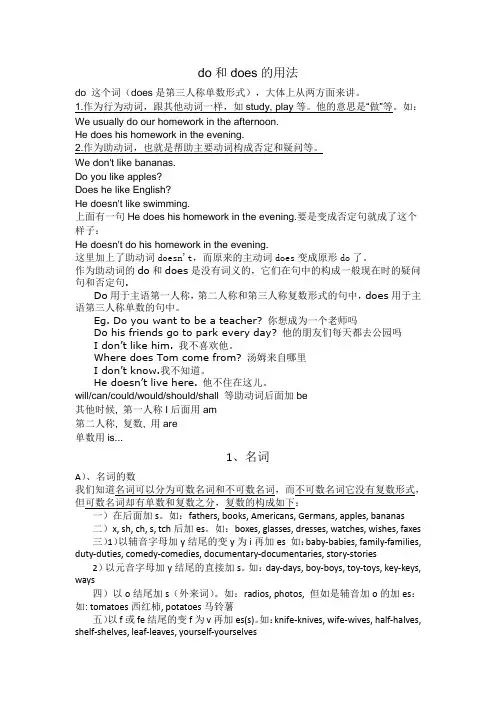
do和does的用法do 这个词(does是第三人称单数形式),大体上从两方面来讲。
1.作为行为动词,跟其他动词一样,如study, play等。
他的意思是“做”等。
如:We usually do our homework in the afternoon.He does his homework in the evening.2.作为助动词,也就是帮助主要动词构成否定和疑问等。
We don't like bananas.Do you like apples?Does he like English?He doesn't like swimming.上面有一句He does his homework in the evening.要是变成否定句就成了这个样子:He doesn't do his homework in the evening.这里加上了助动词doesn't,而原来的主动词does变成原形do了。
作为助动词的do和does是没有词义的,它们在句中的构成一般现在时的疑问句和否定句.Do用于主语第一人称,第二人称和第三人称复数形式的句中,does用于主语第三人称单数的句中。
Eg. Do you want to be a teacher? 你想成为一个老师吗Do his friends go to park every day? 他的朋友们每天都去公园吗I don’t like him. 我不喜欢他。
Where does Tom come from? 汤姆来自哪里I do n’t know.我不知道。
He doesn’t live here. 他不住在这儿。
will/can/could/would/should/shall 等助动词后面加be其他时候, 第一人称I后面用am第二人称, 复数, 用are单数用is...1、名词A)、名词的数我们知道名词可以分为可数名词和不可数名词,而不可数名词它没有复数形式,但可数名词却有单数和复数之分,复数的构成如下:一)在后面加s。
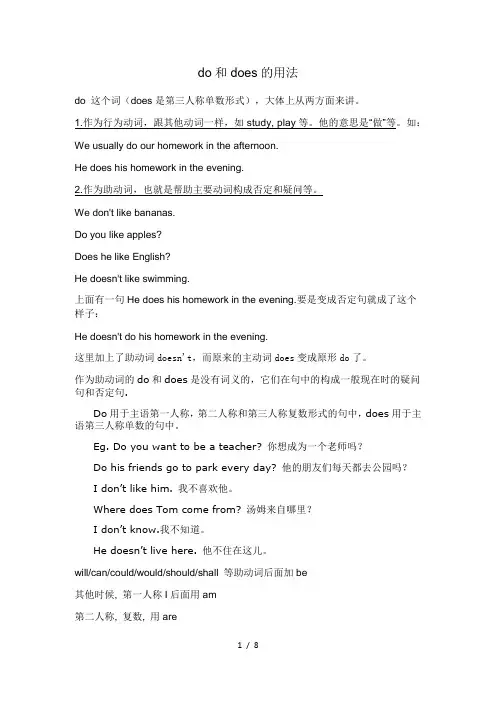
do和does的用法do 这个词(does是第三人称单数形式),大体上从两方面来讲。
1.作为行为动词,跟其他动词一样,如study, play等。
他的意思是“做”等。
如:We usually do our homework in the afternoon.He does his homework in the evening.2.作为助动词,也就是帮助主要动词构成否定和疑问等。
We don't like bananas.Do you like apples?Does he like English?He doesn't like swimming.上面有一句He does his homework in the evening.要是变成否定句就成了这个样子:He doesn't do his homework in the evening.这里加上了助动词doesn't,而原来的主动词does变成原形do了。
作为助动词的do和does是没有词义的,它们在句中的构成一般现在时的疑问句和否定句.Do用于主语第一人称,第二人称和第三人称复数形式的句中,does用于主语第三人称单数的句中。
Eg. Do you want to be a teacher? 你想成为一个老师吗?Do his friends go to park every day? 他的朋友们每天都去公园吗?I don’t like him. 我不喜欢他。
Where does Tom come from? 汤姆来自哪里?I do n’t know.我不知道。
He doesn’t live here. 他不住在这儿。
will/can/could/would/should/shall 等助动词后面加be其他时候, 第一人称I后面用am第二人称, 复数, 用are单数用is...1、名词A)、名词的数我们知道名词可以分为可数名词和不可数名词,而不可数名词它没有复数形式,但可数名词却有单数和复数之分,复数的构成如下:一)在后面加s。
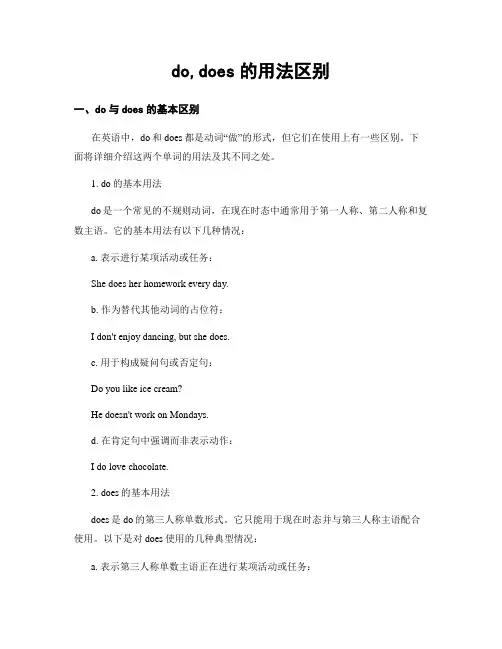
do,does的用法区别一、do与does的基本区别在英语中,do和does都是动词“做”的形式,但它们在使用上有一些区别。
下面将详细介绍这两个单词的用法及其不同之处。
1. do的基本用法do是一个常见的不规则动词,在现在时态中通常用于第一人称、第二人称和复数主语。
它的基本用法有以下几种情况:a. 表示进行某项活动或任务:She does her homework every day.b. 作为替代其他动词的占位符:I don't enjoy dancing, but she does.c. 用于构成疑问句或否定句:Do you like ice cream?He doesn't work on Mondays.d. 在肯定句中强调而非表示动作:I do love chocolate.2. does的基本用法does是do的第三人称单数形式。
它只能用于现在时态并与第三人称主语配合使用。
以下是对does使用的几种典型情况:a. 表示第三人称单数主语正在进行某项活动或任务:He does his exercises three times a week.b. 构成疑问句或否定句:Does she speak French?The car doesn't start in the morning.c. 提供简洁回答:A: Does it rain often in your city?B: Yes, it does.二、do与does的语法差异除了在用法上的区别,do和does还存在一些语法上的差异。
1. 助动词do与does配合的动词是原形:I do my homework.She does her chores.2. 在普通动词后面使用do或does时,该动词要用原形变化:He doesn't like to swim.Do you play the piano?3. 当使用do或does作为主动词时,它们本身已经表达了意思,之后不再需要添加其他动词:Correct: I do my homework every day.Incorrect: I do my homework every day because it is important.三、常见错误及纠正方法在学习英语中,人们常常会犯一些关于do和does用法方面的错误。
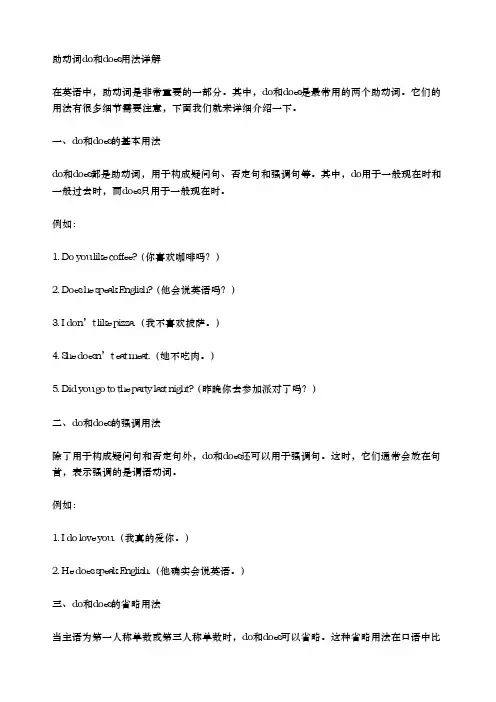
助动词do和does用法详解在英语中,助动词是非常重要的一部分。
其中,do和does是最常用的两个助动词。
它们的用法有很多细节需要注意,下面我们就来详细介绍一下。
一、do和does的基本用法do和does都是助动词,用于构成疑问句、否定句和强调句等。
其中,do用于一般现在时和一般过去时,而does只用于一般现在时。
例如:1. Do you like coffee?(你喜欢咖啡吗?)2. Does he speak English?(他会说英语吗?)3. I don’t like pizza.(我不喜欢披萨。
)4. She doesn’t eat meat.(她不吃肉。
)5. Did you go to the party last night?(昨晚你去参加派对了吗?)二、do和does的强调用法除了用于构成疑问句和否定句外,do和does还可以用于强调句。
这时,它们通常会放在句首,表示强调的是谓语动词。
例如:1. I do love you.(我真的爱你。
)2. He does speak English.(他确实会说英语。
)三、do和does的省略用法当主语为第一人称单数或第三人称单数时,do和does可以省略。
这种省略用法在口语中比较常见。
例如:1. Do you like coffee? → You like coffee?2. Does he speak English? → He speaks English?四、do和does的替换用法为了避免重复,do和does有时也可以替换其他动词。
这种替换用法通常出现在口语中。
例如:1. A: Can you come to my party tonight?B: I’ll do that.(我会去的。
)2. A: Does she like pizza?B: She does.(她喜欢。
)五、do和does的注意事项1. 当do和does用于疑问句时,它们应该放在主语之前。
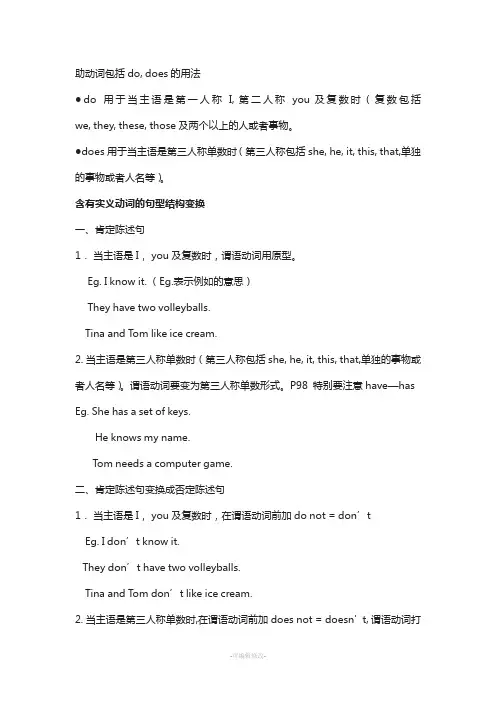
助动词包括do,does的用法●do用于当主语是第一人称I,第二人称you及复数时(复数包括we,they,these,those及两个以上的人或者事物。
●does用于当主语是第三人称单数时(第三人称包括she,he,it,this,that,单独的事物或者人名等)。
含有实义动词的句型结构变换一、肯定陈述句1.当主语是I,you及复数时,谓语动词用原型。
Eg.I know it.(Eg.表示例如的意思)They have two volleyballs.Tina and Tom like ice cream.2.当主语是第三人称单数时(第三人称包括she,he,it,this,that,单独的事物或者人名等)。
谓语动词要变为第三人称单数形式。
P98特别要注意have—has Eg.She has a set of keys.He knows my name.Tom needs a computer game.二、肯定陈述句变换成否定陈述句1.当主语是I,you及复数时,在谓语动词前加do not=don’tEg.I don’t know it.They don’t have two volleyballs.Tina and Tom don’t like ice cream.2.当主语是第三人称单数时,在谓语动词前加does not=doesn’t,谓语动词打回原型Eg.She doesn’t have a set of keys.He doesn’t know my name.Tom doesn’t need a computer game.三、肯定陈述句变换成一般疑问句采用“一加二变三问号”。
一加:当主语是I,you及复数时,在句子开头加do;当主语是第三人称单数时(第三人称包括she,he,it,this,that,单独的事物或者人名等),在句子开头加does;二变:变大小写;第一人称变为第二人称(I/we变为you,my/our变为your);当主语是第三人称单数时,谓语动词要打回原型。
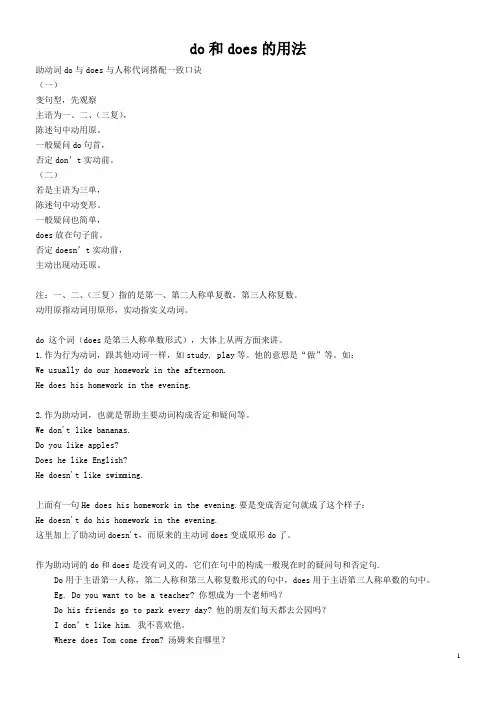
do和does的用法助动词do与does与人称代词搭配一致口诀(一)变句型,先观察主语为一、二、(三复),陈述句中动用原。
一般疑问do句首,否定don’t实动前。
(二)若是主语为三单,陈述句中动变形。
一般疑问也简单,does放在句子前。
否定doesn’t实动前,主动出现动还原。
注:一、二、(三复)指的是第一、第二人称单复数,第三人称复数。
动用原指动词用原形,实动指实义动词。
do 这个词(does是第三人称单数形式),大体上从两方面来讲。
1.作为行为动词,跟其他动词一样,如study, play等。
他的意思是“做”等。
如:We usually do our homework in the afternoon.He does his homework in the evening.2.作为助动词,也就是帮助主要动词构成否定和疑问等。
We don't like bananas.Do you like apples?Does he like English?He doesn't like swimming.上面有一句He does his homework in the evening.要是变成否定句就成了这个样子:He doesn't do his homework in the evening.这里加上了助动词doesn't,而原来的主动词does变成原形do了。
作为助动词的do和does是没有词义的,它们在句中的构成一般现在时的疑问句和否定句.Do用于主语第一人称,第二人称和第三人称复数形式的句中,does用于主语第三人称单数的句中。
Eg. Do you want to be a teacher? 你想成为一个老师吗?Do his friends go to park every day? 他的朋友们每天都去公园吗?I don’t like him. 我不喜欢他。
Where does Tom come from? 汤姆来自哪里?I do n’t know.我不知道。
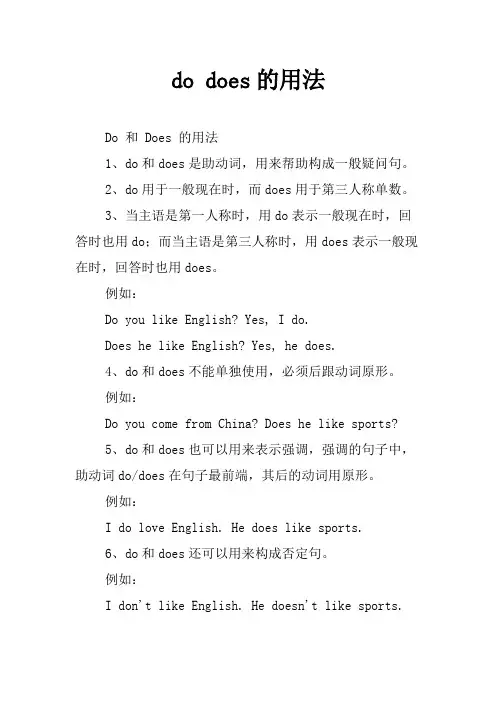
do does的用法Do 和 Does 的用法1、do和does是助动词,用来帮助构成一般疑问句。
2、do用于一般现在时,而does用于第三人称单数。
3、当主语是第一人称时,用do表示一般现在时,回答时也用do;而当主语是第三人称时,用does表示一般现在时,回答时也用does。
例如:Do you like English? Yes, I do.Does he like English? Yes, he does.4、do和does不能单独使用,必须后跟动词原形。
例如:Do you come from China? Does he like sports?5、do和does也可以用来表示强调,强调的句子中,助动词do/does在句子最前端,其后的动词用原形。
例如:I do love English. He does like sports.6、do和does还可以用来构成否定句。
例如:I don't like English. He doesn't like sports.7、do和does与疑问副词when、where、why、how一起使用时,用来构成特殊疑问句。
例如:Why do you like English? Where does he live?8、另外,do和does还可以表示某一行为或动作的习惯性或者频率,表示现在时,这种情况下do/does要紧跟动词原形,并且动词要用现在分词形式。
例如:He always does his homework on time. She never does her homework carelessly.。
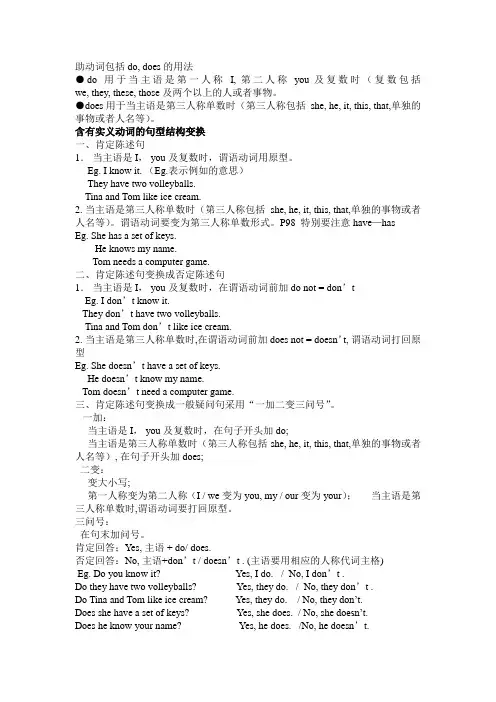
助动词包括do, does的用法●do用于当主语是第一人称I, 第二人称you 及复数时(复数包括we, they, these, those及两个以上的人或者事物。
●does 用于当主语是第三人称单数时(第三人称包括she, he, it, this, that,单独的事物或者人名等)。
含有实义动词的句型结构变换一、肯定陈述句1.当主语是I, you及复数时,谓语动词用原型。
Eg. I know it. (Eg.表示例如的意思)They have two volleyballs.Tina and Tom like ice cream.2. 当主语是第三人称单数时(第三人称包括she, he, it, this, that,单独的事物或者人名等)。
谓语动词要变为第三人称单数形式。
P98 特别要注意have—has Eg. She has a set of keys.He knows my name.Tom needs a computer game.二、肯定陈述句变换成否定陈述句1.当主语是I, you及复数时,在谓语动词前加do not = don’tEg. I don’t know it.They don’t have two volleyballs.Tina and Tom don’t like ice cream.2. 当主语是第三人称单数时,在谓语动词前加does not = doesn’t, 谓语动词打回原型Eg. She doesn’t have a set of keys.He doesn’t know my name.Tom doesn’t need a computer game.三、肯定陈述句变换成一般疑问句采用“一加二变三问号”。
一加:当主语是I, you及复数时,在句子开头加do;当主语是第三人称单数时(第三人称包括she, he, it, this, that,单独的事物或者人名等), 在句子开头加does;二变:变大小写;第一人称变为第二人称(I / we变为you, my / our变为 your);当主语是第三人称单数时,谓语动词要打回原型。
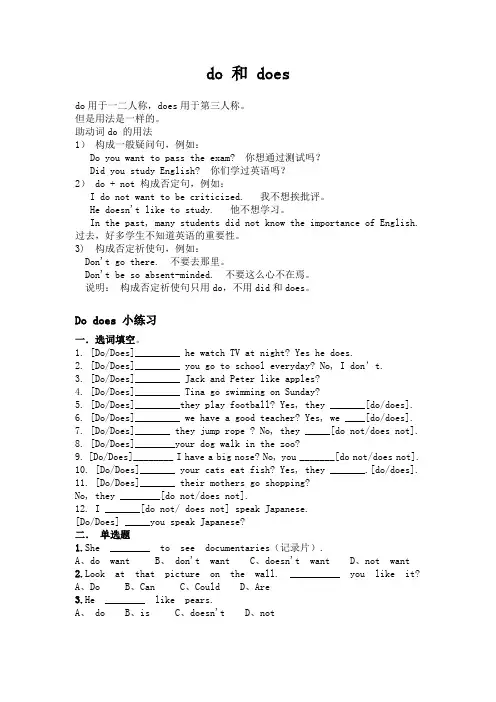
do 和 doesdo用于一二人称,does用于第三人称。
但是用法是一样的。
助动词do 的用法1)构成一般疑问句,例如:Do you want to pass the exam? 你想通过测试吗?Did you study English? 你们学过英语吗?2) do + not 构成否定句,例如:I do not want to be criticized. 我不想挨批评。
He doesn't like to study. 他不想学习。
In the past, many students did not know the importance of English. 过去,好多学生不知道英语的重要性。
3) 构成否定祈使句,例如:Don't go there. 不要去那里。
Don't be so absent-minded. 不要这么心不在焉。
说明:构成否定祈使句只用do,不用did和does。
Do does 小练习一.选词填空。
1. [Do/Does]_________ he watch TV at night? Yes he does.2. [Do/Does]_________ you go to school everyday? No, I don’t.3. [Do/Does]_________ Jack and Peter like apples?4. [Do/Does]_________ Tina go swimming on Sunday?5. [Do/Does]_________they play football? Yes, they _______[do/does].6. [Do/Does]_________ we have a good teacher? Yes, we ____[do/does].7. [Do/Does]_______ they jump rope ? No, they _____[do not/does not].8. [Do/Does]________your dog walk in the zoo?9. [Do/Does]________ I have a big nose? No, you _______[do not/does not].10. [Do/Does]_______ your cats eat fish? Yes, they _______.[do/does].11. [Do/Does]_______ their mothers go shopping?No, they ________[do not/does not].12. I _______[do not/ does not] speak Japanese.[Do/Does] _____you speak Japanese?二.单选题1.She ________ to see documentaries(记录片).A、do wantB、 don't wantC、doesn't wantD、not want2.Look at that picture on the wall. __________ you like it?A、DoB、CanC、CouldD、Are3.He ________ like pears.A、 doB、isC、doesn'tD、not4.—Do you often go to the cinema______ Sunday?—No, we__________.A、on, don'tB、on, aren'tC、in, doD、in, don't5.-Can you see a light on the table?-Yes, ________.A、I amB、I’m notC、I canD、He isn’t6.—Does the boy want to be an actor? —________.A、 Yes, he isB、No, he doesC、Yes, he doesD、No, he isn't7._________ he have any apples ?A、DoB、DoesC、IsD、Are8.She ______ want to be a policewoman, because she thinks it’s kind of dangerous.A、isn’tB、aren’tC、don’tD、doesn’t9.Why____he have brown hair?A、 doB、doesC、isD、has10.What time__________ he get home every day?A、isB、doesC、doD、am11.What________ you see in the picture?A、isB、areC、canD、have12.Jack_______ like flying kites______ throwing a frisby.A、don't, orB、doesn't, andC、 don't, andD、doesn't, or13.A:________ Jim ________ a ball?B:No, he________.A、Do, have, don'tB、Does, has, doesn'tC、Is, have, isn'tD、Does, have, doesn't14.I ________ have a watch.A、 am notB、doesC、don'tD、doesn't15.____you____a good time on your vacation?A、Did; haveB、Did; hadC、Were; haveD、Were; had16.Simon likes _____ football, but he doesn’t_____ it well.A、 play, playsB、to play, playsC、plays, playingD、playing, play17.She____have to wash the dishes now.A、don'tB、notC、doesn'tD、can't18.—________Colin ________ Chinese history? —Yes, he does.A、Do; likeB、Does; likesC、Do; likesD、Does; like19.Li Lei ______ lunch at home.A、hasn’tB、haven’tC、don’t haveD、doesn’t have20.-Who cleaned the blackboard yesterday, Dick? -John___.A、cleanedB、doesC、didD、is21.__________ you usually come to school by bike?A、Don'tB、Doesn'tC、Aren'tD、Isn't22.-Where______lions come from? -I think they come from Africa.A、areB、isC、doesD、do23.__________ we have any eggs?A、Aren'tB、Don'tC、Can'tD、Mustn't24.____you on your vacation yesterday?A、AreB、WereC、WasD、Did25.-Who____dinner last night? -My mother____.A、cooked; didB、did; cookedC、did; didD、cooked; cooked三.考考你的眼力,看看谁才是真正的小侦探!1. Do he jump rope everyday?2. Does Tina and Linda like bananas?3. Does she watches TV at night?4. Does you go to school on Monday?5. Do they speak Chinese? No, they does not.6. Does Lily plays football? Yes, she does.7. Does they work in the fire station?8. Do you works in the department store?9. Does she swim in the pool? Yes, she does not.。
疑问句中do和does的用法一、do和does的基本用法疑问句中,“do”和“does”是两个常用的助动词,用于构成一种特殊的句型,即疑问句。
在英语中,“do”和“does”分别表示行为,它们在不同的人称和时态下有着不同的形式。
具体来说,我们可以简单地总结为:1. 在一般现在时(Simple Present Tense)中,对于第三人称单数(He/She/It),我们使用“does”,而对于其他人称以及复数形式,则使用“do”。
例句:- Does he like coffee?- Do you play basketball?- Do they study English?2. 在一般过去时(Simple Past Tense)和一般未来时(Simple Future Tense)中,无论什么人称都要使用“do”。
这也是它们与一般现在时的主要区别。
例句:- Did he go to the party?- Do you think it will rain tomorrow?二、疑问句中do和does的含义差异尽管“do”和“does”的形式上有所差异,但它们在疑问句中所表达的含义其实是相同的。
它们都用于询问对方是否从事某种活动或者对某件事情持有何种看法。
当我们用这两个助动词引导疑问句时,常常需要根据具体语境来决定是选择“do”还是“does”,以便与特定的主语形式相匹配。
所以说,“do”和“does”的用法实际上只是根据句子的主语而产生的变化。
三、其他用途除了疑问句,助动词“do”和“does”还有一些其他的用法。
1. 强调句:在某些情况下,我们可以使用助动词“do”或“does”来强调谓语动词。
这种结构在口语中比较常见。
例句:- I do like pizza.- He does have a car.2. 否定句:要构成一般现在时或一般过去时的否定句,我们需要在助动词不变的情况下,在其后加上“not”。
助动词包括do, does的用法●do用于当主语是第一人称I, 第二人称you 及复数时(复数包括we, they, these, those及两个以上的人或者事物。
●does 用于当主语是第三人称单数时(第三人称包括she, he, it, this, that,单独的事物或者人名等)。
含有实义动词的句型结构变换一、肯定陈述句1.当主语是I, you及复数时,谓语动词用原型。
Eg. I know it. (Eg.表示例如的意思)They have two volleyballs.Tina and Tom like ice cream.2.当主语是第三人称单数时(第三人称包括she, he, it, this, that,单独的事物或者人名等)。
谓语动词要变为第三人称单数形式。
P98 特别要注意have—has Eg. She has a set of keys.He knows my name.Tom needs a computer game.二、肯定陈述句变换成否定陈述句1.当主语是I, you及复数时,在谓语动词前加do not = don’tEg. I don’t know it.They don’t have two volleyballs.Tina and Tom don’t like ice cream.2.当主语是第三人称单数时,在谓语动词前加does not = doesn’t, 谓语动词打回原型Eg. She doesn’t have a set of keys.He doesn’t know my name.Tom doesn’t need a computer game.三、肯定陈述句变换成一般疑问句采用“一加二变三问号”。
一加:当主语是I, you及复数时,在句子开头加do;当主语是第三人称单数时(第三人称包括she, he, it, this, that,单独的事物或者人名等), 在句子开头加does;二变:变大小写;给大家推荐一个英语微信群-Empty Your Cup英语微信群是目前学习英语最有效的方法,群里都是说英语,没有半个中文,而且规则非常严格,是一个超级不错的英语学习环境,群里有好多英语超好的超牛逼的人,还有鬼佬和外国美眉。
助动词dodoes的用法小学助动词 do/does 的用法小学小朋友们,今天我们要来学习英语中非常重要的助动词 do 和 does 的用法。
这两个词虽然看起来简单,但是用对它们可不那么容易哦!让我们一起来探索一下吧。
首先,我们要知道 do 和 does 是用来帮助构成疑问句和否定句的。
那什么时候用 do ,什么时候用 does 呢?当主语是第一人称 I 、第二人称 you ,还有复数形式的 we 、they 以及其他复数名词时,我们要用 do 。
比如说:I do my homework every day(我每天做作业。
)You do a good job(你做得很好。
)We do sports in the morning(我们早上做运动。
)They do like apples(他们确实喜欢苹果。
)而当主语是第三人称单数,像 he 、she 、it 或者是单个的人名,比如 Tom 、Lucy 等时,我们就要用 does 啦。
例如:He does his homework carefully(他认真做作业。
)She does well in math(她数学学得好。
)It does not rain today(今天没下雨。
)Tom does not like football(汤姆不喜欢足球。
)接下来,我们看看 do 和 does 是怎么帮助构成疑问句的。
如果句子的主语是 I 、you 、we 、they 或者复数名词,我们就在句首加上 do ,然后把句中的动词变回原形。
比如:Do you like ice cream? (你喜欢冰淇淋吗?)Do they play football on Sundays? (他们星期天踢足球吗?)要是句子的主语是 he 、she 、it 或者单个的人名,那就在句首加上does ,同样要把句中的动词变回原形。
像:Does she go to school by bike? (她骑自行车上学吗?)Does Tom have a pen? (汤姆有一支钢笔吗?)再说说否定句。
助动词do和does的用法
do与does都是助动词,是一些动词后面的助词,只能用于现在时态和一般疑问句。
一、do常用来作为谓语:
(1)do谓语用法只在第三人称单数形式下,即he、she、it和名词单数形式时才使用:
例如:He does his homework early in the morning.(他早上做他的作业)(2)do也用于一般疑问句中:
例如:
Do you cook dinner every night?(你每晚做饭吗?)
二、does也只用于现在时态:
(1)在第三人称单数时,要用does:
例如:Does he go to school every day?(他每天去上学吗?)
(2)does也用于一般疑问句中:
例如:Does she go to the cinema tonight?(她今晚去电影院吗?)
总而言之,do和does的用法十分简单,但却非常重要,要牢记它们的用法。
一般情况下,do用于第三人称单数形式,而does则用于现在时态以及一般疑问句,即he、she、it的一般疑问句和you的疑问句中。
另外,要特别注意的是,当动词本身用了第三人称单数形式,不用再
加上do或does,而是用动词本身。
例如:She teaches English.(她教英语)
以上就是关于do和does用法的简要介绍,大家要牢记它们的用法,切不可混淆。
do和does的人称用法在英语语法中,do和does通常被用作助动词,主要用于提问和否定句中。
它们的使用取决于主语的人称和数量。
以下是关于do和does的人称用法的详细信息。
首先,do常被用于第一人称、第二人称,以及第三人称复数的主语后面。
例如,我们(第一人称复数)通常会说,“我们喜欢阅读(We do like reading)。
” 另一个例子是,“你(第二人称单数)做你的家作了吗(Did you do your homework)?”而对于第三人称复数,可以说,“他们(第三人称复数)今天不工作(They do not work today)。
”其次,does适用于第三人称单数的主语后面。
例如,“他(第三人称单数男性)确实喜欢足球(He does like football)。
”另一种常见的用法是,在提问句中,我们通常会说,“她(第三人称单数女性)做她的家作了吗(Does she do her homework)?” 对于否定句,我们可以说,“他(第三人称单数男性)今天不工作(He does not work today)。
”此外,在英语语法中,do和does在时间方面也有所不同。
do通常被用于现在时和过去时,而does则主要被用于现在时。
例如,“我昨天做了我的家作(I didmy homework yesterday)”或“我通常在晚上做我的家作(I do my homework at night)”。
而对于does的用法,我们可以说,“他每天都去跑步(He does jogging every day)”。
总的来说,do和does在人称和数量方面的使用大致遵循上述规则。
但需要注意的是,这其中也有一些例外情况。
例如,在一些非正式的口语环境中,人们可能会忽略这些规则。
而在一些特定的表达方式和语境中,do和does的使用也可能会有所不同。
在实际的语言应用中,一般会根据具体的语境和需要选择合适的表达方法。
助动词do/does用法(目前只学了一般现在时,以下内容均针对一般现在时)1. 当主语是第一、二人称或复数时:①陈述句:谓语动词用原形例句:I/You/We/They/The students/My parents/Our friends like English.②疑问句:在陈述句基础上,将助动词do放主语前面,首字母大写,末尾加问号。
若主语是I,要变you, 主语含my要变your, 含our要变your!!!例句:Do you/you/you(你们)/they/the students/your parents/your friends like English?③否定句:在陈述句基础上,在实义动词前加上don’t例句:I/You/We/They/The students/My parents/Our friends don’t like English.2.当主语是第三人称单数时(即满足两个条件,一是第三人称,二是单数,简称“三单”):①陈述句:谓语动词用第三人称单数形式,变化规则请看课本91面例句:He/She/It/Tom/His mother/Her friend/My sister/Your teacher eats an apple.②疑问句:在陈述句基础上,将助动词does放主语前面,首字母大写,末尾加问号。
若主语含my要变your, 含our要变your,谓语动词变原形!!!例句:Does he/she/it/Tom/ his mother/her friend/your sister/your teacher eat an apple?③否定句:在陈述句基础上,在实义动词前加上doesn’t,其后面的动词变原形!!!例句:He/She/It/Tom/His mother/Her friend/My sister/Your teacher doesn’t eat an apple.名词解释(由于语法解释涉及到其他专有名词,因此以下均为简单介绍):1.主语:动作的发出者或句子陈述的主要对象。